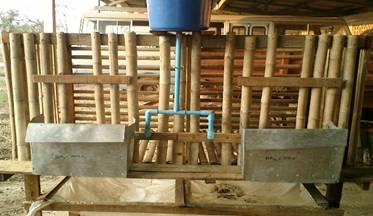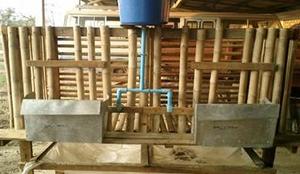Pigtrop - Le centre d'information sur l'élevage porcin et les filières porcines des pays du Sud
- Lutte contre les maladies
- Alimentation adaptée
- Stratégies génétiques
- Protection des ressources naturelles
- Socio-économie de la filière porcine
- Risque alimentaire et qualité sanitaire
- Techniques d'élevage
- Développement rural
Stylosanthes and cassava leaves | Stylosanthes and cassava leaves as protein supplements to a basal diet of broken rice for local pigs in Lao PDR
Four local castrated male pigs of 12.5 to 18.5 kg were used to study the effect of stylosanthes leaves and cassava leaves fed alone or as mixtures on the intake, nutrient digestibility and N balance on a basal diet of broken rice (with the permission of Livestock Research for Rural Development).
Introduction
There is presently much interest in tropical countries in the use of cassava leaves as a replacement for soya bean meal and fish meal in pig diets (Preston 2001). In the earky experiments the leaves were either dried or ensiled (Bui Huy Nhu Phuc et al 1996), to avoid potential toxicity problems due to the cyanogenic glucosides in the fresh cassava leaves (Tewe 1991). More recently, fresh cassava leaves were successfully fed at 25% of the diet DM, as the only supplement to broken rice, but overall dietary intakes were rather low (Nguyen Duy Quynh Tram 2003). Fresh stylo foliage (Stylo CIAT 184) has also been used as a protein supplement for local pigs and increased the growth rates when added to a basal diet of maize and rice bran (Chanphone Keoboualapheth and Choke Mikled 2003).
As both cassava and stylosanthes are widely grown in Lao, it was hypothesized that mixtures of fresh cassava leaves and stylo would support higher intakes of DM and better performance in local pigs than either forage fed alone as the only supplement to broken rice.
Materials and methods
Location and duration
The experiment was conducted at the Livestock Research Center of the National Agriculture and Forestry Institute (NAFRI), Namxuang about 44 km from Vientiane city, Lao PDR from 3 November to 21 December 2003.
Treatments and design
There were four treatments:
- CA: Fresh cassava leaves (without petioles or stems) chopped into small pieces (2-3cm) and fed immediately after chopping (offered once daily).
- ST: Fresh Stylo leaves stripped from the stems
- CAST: Mixture of CA and ST in proportions of 65:35 (DM basis)
- STCA: Mixture of CA and ST in proportions of 35:65 (DM basis)
The experimental design was a Latin square 4*4 arrangement with 4 pigs and 4 periods.
Animals and housing
Four local pigs with live weight from 12.5 to 18.5 kg were used in the experiment. The pigs were housed in bamboo metabolism cages that allow the separate collection of urine and faeces (Photo1). The size of the metabolism cage was 0.8m x 0.8m (Chhay Ty et al 2003a). The experimental periods were each of 14 days: 9 days for adaptation period to allow the pigs to become familiarized with the new diet and a five-day period for collection of faeces and urine.

Feeds and feeding system
Broken rice was fed at the rate of 2.5% (DM basis) of live weight. The cassava leaves were harvested from 5 month-old plants grown in plots at the Livestock Research Center. The leaves were separated from the petioles and stems, chopped to about 2 to 3cm length and offered immediately to the pigs. Small amounts of sugar (<5 g) were applied to the cassava leaves to improve palatability. The stylo was of unknown age when harvested. The leaves were stripped from the stems and fed immediately.
Measurements
Urine and faeces of each pig were collected separately and weighed daily every morning and stored at -20 0C. Urine was collected in a bucket via a plastic sheet and funnel placed below the cage. To prevent nitrogen losses by evaporation of ammonia, the pH was kept below pH 4 by collecting the urine in 10ml of 10% sulphuric acid. The urine and faeces from each animal were collected for five days and at the end of the period, the faeces were mixed, ground and representative sample taken for analysis. Dry matter of feed offered and refused and DM in faeces were done by microwave radiation (Undersander et al 1993). Nitrogen in faeces and nitrogen in urine, and in feeds offered and refused, were determined according to the Kjeldahl method (AOAC 1990).
Statistical analysis
The data were analysed using the GLM option of the Minitab (version 13.31) ANOVA software. Sources of variation were source of leaves, periods, pigs and error.
Results and discussion
Feed characteristics
The N content of cassava leaves in this experiment (Table 2) was higher than in the reports of Nguyen Duy Quynh Tram (2003) and Eggum (1970). The values for stylo leaves were higher than those reported by Chanphone Keoboualapheth and Choke Mikled (2003).
Feed intake
All the broken rice was consumed. Total feed DM intake was higher when cassava leaves were fed alone or mixed with stylo as compared with stylo as the only supplement (Table 3 and Figure 1). In this study the intake of cassava leaves was higher (159 g DM/day) than in the report of Nguyen Duy Quynh Tram (2003) where the intake was only 58g DM/day. The reason may be that in the study of Nguyen Duy Quynh Tram (2003), the leaves were collected from mature cassava plants (about 9 months old) from commercial farms, whereas in the present experiment the cassava plants were only 5 months old. In an earlier paper with pigs fed broken rice (Chhay Ty et al 2003), it was shown that the intakes and the digestibility of the dry matter were higher when the supplement was ensiled young compared with ensiled old cassava leaves. The low intake of stylo when it was the only forage supplement is similar to what was reported by Chanphone Keoboualapheth and Choke Mikled (2003) who fed stylo foliage as a supplement to rice bran. The dry matter intake as percentage of body weight was higher (3.11) for the CA100 diet compared with the report of Nguyen Duy Quynh Tram (2003) (2.6% body weight). This reflected the differences in intake of the cassava leaves in the two experiments. There were no differences in intake of crude protein among the four diets.
There were no differences among treatments in digestibility of dry matter and N (Table 4). The values were lower than those reported by Nguyen Duy Quynh Tram (2003) (89.1 and 73.9%, respectively for DM and N), probably because there was a higher proportion of broken rice in the diet in the latter experiment and broken rice can be expected to have a higher DM and N digestibility than cassava leaves.
N intakes were similar on the 4 diets; however, although the differences among diets were not significant (Table 5), there was a curvilinear relationship between daily N retention and the proportion of cassava leaves in the foliage (Figure 2). The values for N retention, N retention as percentage of intake and N retention as percentage of N digested on the 100% cassava leaf supplement, were all higher that was reported by Nguyen Duy Quynh Tram (2003) for similar diets but with "older" cassava leaves.
Conclusions
* On a basal diet of broken rice supplemented with leaves of cassava and/or stylo fed to pigs of 12 to 18 kg, the foliage DM intake was higher when cassava leaves were fed alone or mixed with stylo leaves, as compared with stylo alone.
* There was a positive curvilinear relationship between the proportion of cassava leaves in the foliage supplement and N retention.
Acknowledgements
The authors would like to thank SIDA-SAREC for funding this experiment through the MEKARN regional project, and staff of the Livestock Research Center, NAFRI, for their cooperation.
References
- AOAC 1990 Official methods of analysis. Association of Official Analytical Chemists, Arlington, Virginia, 15th edition, 1298 pp.
- Bui Huy Nhu Phuc, Preston T R, Ogle B and Lindberg J E 1996 The nutritive value of sun-dried and ensiled cassava leaves for growing pigs. Livestock Research for Rural Development (8) 3: http://www.cipav.org.co/lrrd/lrrd8/3/phuc83.htm
- Chanphone Keoboualapheth and Choke Mikled 2003: Growth Performance of Indigenous Pigs Fed with Stylosanthes guianensis CIAT 184 as Replacement for Rice bran; Livestock Research for Rural Development (15) 9 Retrieved March 5, 2004, from http://www.cipav.org.co/lrrd/lrrd15/9/chan159.htm
- Chhay Ty, Preston T R and Ly J 2003a: The use of ensiled cassava leaves in diets for growing pigs. 1. The effect of graded levels of palm oil on N digestibility and N balance; Livestock Research for Rural Development (15) 7 Retrieved , from http://www.cipav.org.co/lrrd/lrrd15/7/chha157.htm
- Chhay Ty, Preston T R and Ly J 2003b: The use of ensiled cassava leaves in diets for growing pigs. 2. The influence of type of palm oil and cassava leaf maturity on digestibility and N balance for growing pigs. Livestock Research for Rural Development (15) 8 Retrieved , from http://www.cipav.org.co/lrrd/lrrd15/8/chha158.htm
- Eggum O L 1970 The protein quality of cassava leaves. British Journal of Nutrition 24: 761-769
- Nguyen Duy Quynh Tram 2003 Effect of method of processing cassava leaves on intake, digestibility and N retention by Ba Xuyen piglets and HCN content of the leaves. MEKARN Mini-projects 2003 MSc course. Retrieved October 10, 2003, from MEKARN Mini-projects. http://www.mekarn.org/MSc 2003-05/miniprojects/web page/tram.htm
- Preston T R 2001 Potential of cassava in integrated farming systems; In: International Workshop on Current Research and Development on Use of Cassava as Animal Feed (Editor: TR Preston). http://www.mekarn.org/prockk/pres.htm
- Tewe O O 1991 Detoxification of cassava products and effects of residual toxins on consuming animals. In: Roots, tubers, plaintains and bananas in animal feeding (Editors: D H Machin and S V Nyvold), APHP paper 95, FAO: Rome
- Undersander D, Mertens D R and Theix N 1993 Forage analysis procedures. National Forage Testing Association. Omaha pp 154.
Citation of this paper
Commentaires
CIRAD © 2007 (Tous droits réservés) - Informations légales - Page mise à jour : 12/04/2007
